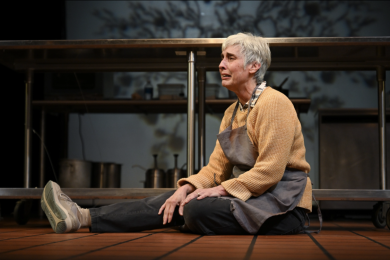Harder to remount than you might think
On paper, South Pacific sounds like a foolproof candidate for a modern remounting, a rollicking musical boasting a fistful of certifiably classic tunes and a message of racial tolerance. On the other hand, what played as progressive in 1949 doesn’t necessarily translate to 2016, which makes Joe Haj’s first directorial effort since taking over as the Guthrie’s Artistic Director more of a risk than it might initially seem. Fortunately for all involved, the gamble mostly pays off, and what failings there are are more attributable to Rodgers and Hammerstein and their era than to Haj and his team.
Let’s start with the element that draws most folks to a show like South Pacific, the songs. It would be hard to go wrong with this lineup of tunes, and this production nails it even harder than might be expected. Edward Staudenmayer, playing fugitive French paramour Emile de Becque, makes maybe the biggest impression, with a rich, operatic singing voice that wrings amazing amounts of emotion out of “Some Enchanted Evening.”
Erin Mackey, as plucky, prejudiced Ensign Nellie Forbush, brings bountiful energy and a versatile voice to the role, particularly during an infectious “I’m Gonna Wash That Man Right Outa My Hair” dance number centered around a working onstage shower. C.J. Eldred’s vocal presence as the lovestruck Lt. Cable is less flamboyant than his fellow leads’, but it’s an ideal delivery system for a stark, bittersweet rendition of “You’ve Got to Be Carefully Taught,” the show’s anti-racist signature song.
A lovely thing to hear, and to look at
Of course, a musical number doesn’t live on vocals alone. Haj’s direction, Daniel Pelzig’s choreography and John Lee Beatty’s set design gel wonderfully on production numbers both boisterous (“There is Nothing Like a Dame,” the aforementioned “Wash That Man” shower dance), and somber (“Bali Hai,” a stirring ensemble reprise of “Honey Bun” set to a spare drumbeat). Conductor Tim Weil’s orchestra is onstage but unobtrusive, nestled in a gorgeous backdrop that evokes the sunsets, starry nights and coral reefs of the Pacific Islands. This show would be a lovely thing to look at even if it wasn’t nearly so entertaining.
South Pacific is also a prime example of the Mercutio factor, where a role is so juicy that it can easily inflate the audience’s estimation of the performer embodying it. There are two such roles here: Bloody Mary, the Tonkinese entrepreneur who serves as the island’s mother figure, and Seabee Luther Billis, the good-natured schemer who provides much of the play’s comic relief. They’re the flashiest roles in the production, and both actors exceed expectations as they push them into surprising places.
Billis provides ample opportunity for scenery-chewing, and Jimmy Kieffer happily obliges with a joyful performance that’s plenty big but never overbearing. While it would be easy and understandable to play it broad, Kieffer injects Billis with a wounded nobility that compliments his exquisitely old-fashioned comic timing. It’s about as restrained a turn as you’d want for a role that includes numerous double-takes and a dance number in a coconut bra.
Sidestepping the landmines of stereotypes
Bloody Mary is probably the role with the most riding on it in a modern context a part fraught with racial landmines. She speaks heavily accented English, embodies the “shrewd Asian businessperson” stereotype, and more or less pimps out her daughter at the first sight of a handsome American serviceman. Somehow, though, Christine Toy Johnson manages to not just sidestep those problems, but also fold them into a complex and hugely sympathetic portrayal. Johnson plays Bloody Mary as a survivor with an inborn ability to adapt to her time and situation. Even when she’s clowning for the sailors or dithering over grass skirts, she exudes a blend of strength and vulnerability that makes Bloody Mary arguably the production’s most compelling presence.
Of course, the prominence of Bloody Mary also underscores one of the areas in which South Pacific has aged less gracefully. In 1949 it was gutsy for Rodgers and Hammerstein to broach the topic of racism in a big-budget musical, let alone to channel it through the show’s otherwise sympathetic heroine. In 2016, though, it’s hard not to notice when an Asian-set play featuring multiple Asian characters affords only one of them a major speaking role.
Of the others, de Becque’s two young children (Louisa Darr and Gavihn Lee) and Bloody Mary’s daughter Liat (Manna Nichols) are all vital to the narrative. The actors do an admirable job of breathing life into them, but as written they’re still mostly plot devices, and problematic ones at that. Lt. Cable’s arranged love affair with Liat can’t help but stir up questions of consent, particularly when he rapturously sings of her being “Younger Than Springtime.”
Since not much can be done to amend those prickly issues short of some major script-tinkering, perhaps it’s best taken as a lesson on the progress of progressivism.
There are a few more nits one could pick with South Pacific. Storytelling sometimes takes a backseat to spectacle, and some of the character development feels rushed and unearned - Nellie’s awakening to tolerance seems especially sudden. Still, none of those problems are inherent to this otherwise masterful Guthrie production. Haj and his team have put together a visually and aurally striking revival that largely overcomes the limitations of its vintage. It’s a fine chunk of entertainment for a hot summer night.




